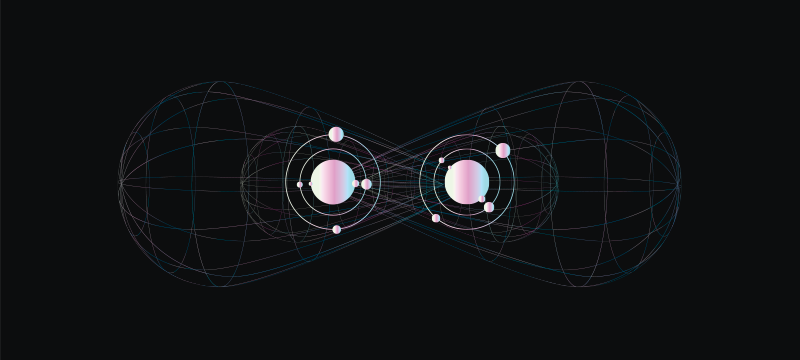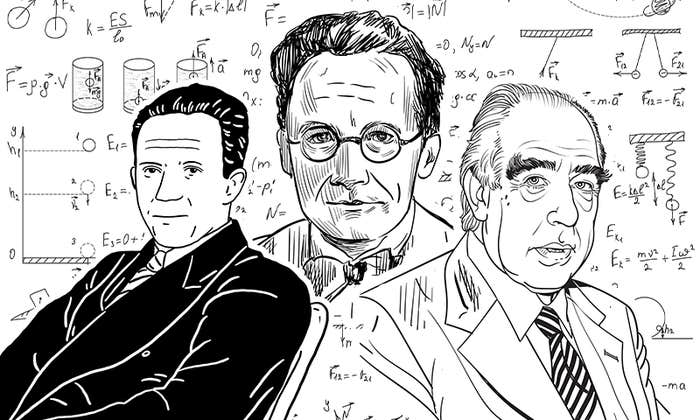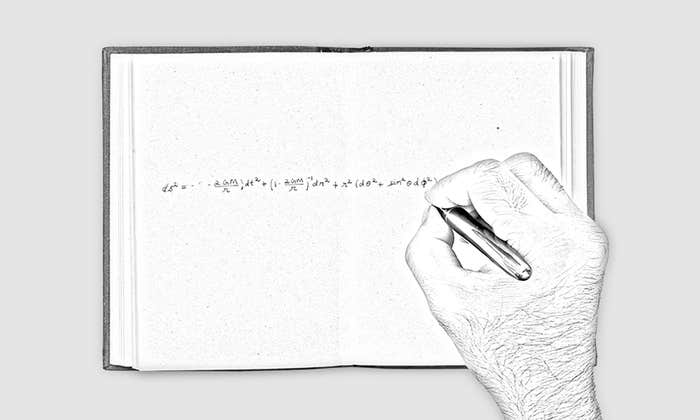Among the quirks that my wife chooses to find amusing, I have a habit of waking up extra early every year on the first Tuesday of October. That’s the time when the Royal Swedish Academy of Sciences announces new recipients of the Nobel Prize in Physics. I have been repeating this ritual every year for about a dozen years, waiting—hoping—to hear a particular announcement. This year it finally arrived.
The winners of the Nobel Prize in Physics for 2022, Alain Aspect, John Clauser, and Anton Zeilinger, have been pioneers in the study of quantum entanglement, one of the most beguiling features of quantum theory. Albert Einstein and colleagues helped to identify the notion back in the 1930s, only to reject the idea as too outlandish to be true. Thirty years later, physicist John Bell introduced an ingenious way to design an experimental test that might confirm or rule out such strange-sounding behavior.
Quantum theory predicts that if two or more particles are prepared in a particular way, their behavior should remain correlated, even after they have moved very far apart. Perform a measurement of some property of particle A and—wham!—particle B should display specific behavior, even if they are light-years apart. Stranger still, the particles’ properties should align even when physicists measure different properties of each particle, selecting the measurements to perform on each member of the pair at random.

The experiments that Bell had in mind were clever, and they also seemed feasible. No need to build a huge particle accelerator or launch a massive new satellite. And yet years went by before other physicists even cited Bell’s article, let alone rolled up their sleeves to give it a go.
One of the first to reach out to Bell was a young John Clauser. Clauser had stumbled upon Bell’s article while browsing journals in the library as a graduate student. Excited by what he read, he rushed to his Ph.D. supervisor to suggest they conduct the type of experiment that Bell had proposed. To Clauser’s frustration, his advisor responded with (no doubt well-intentioned) advice: Stick with more mainstream topics for the dissertation, don’t chase such “philosophical” topics as entanglement.
Yet Bell’s idea stuck, and a few years later, as Clauser was preparing for his postdoctoral position at the Lawrence Berkeley National Laboratory, he wrote to Bell to ask if other physicists had conducted any such tests in the interim. As Bell later recalled, Clauser’s letter was the first time any experimental physicist had evinced interest in Bell’s work. Bell quickly responded: If Clauser did manage to measure behavior different than the quantum predictions—and hence more in line with Einstein’s expectations—that would “shake the world!”
I had the great luck to partner with Anton Zeilinger and his group on “Cosmic Bell” tests.
With Bell’s encouragement, along with critical input from a few like-minded colleagues, Clauser and Stuart Freedman (a graduate student at the time) set out to conduct the first Bell test. After scrounging for spare parts around the laboratory, they managed to collect data on thousands of pairs of particles, finding exactly the correlated behavior predicted by quantum theory. They published their results in a flagship journal in 1972, and then … nothing. The following year, citations to Bell’s work, previously just a trickle, dropped by more than half. Some academic leaders doubted whether investigations of entanglement counted as “real physics.”
An ocean away, just outside Paris, Alain Aspect had also become captivated by entanglement. Like Clauser, he aspired to conduct a Bell test in a laboratory. His main ambition was to perform an experiment that could home in on the instantaneousness of entanglement. He made a pilgrimage to CERN in Geneva, where Bell worked, to ask Bell himself whether such an experiment would be worthwhile. Bell’s first question: “Do you have a permanent position?” The topic still moldered on the margins.
Like Clauser, Aspect pressed on. In a virtuoso experiment with colleagues in 1982, Aspect used super-fast switches that could change each particle’s path en route to the measuring devices. The switches changed back and forth 100 million times per second. The detector toward which a given particle would be directed was determined while that particle was in flight. Moreover, the two measuring stations were far enough apart that information from one side of Aspect’s experiment couldn’t possibly be communicated to the other side before measurements on both particles had been completed. Aspect and his colleagues sent nearly a trillion pairs of particles through the apparatus and they, too, found the spooky correlations precisely as quantum theory predicted.
At first Aspect’s beautiful experiment, like Clauser’s a decade earlier, was met with a collective shrug. For the next several years he focused on other areas of physics, frustrated by many colleagues’ indifference to topics like entanglement.
They published their results in a flagship journal in 1972, and then … nothing.
The third recipient of this year’s prize, Anton Zeilinger, showed equal tenacity, ingenuity, and persistence. With several colleagues he extended Bell’s work to the case of three or more entangled particles. In the 1990s, he and his group first succeeded in teleporting an entangled state, transferring the special correlated behavior to a third particle. Soon after that, his group measured the tell-tale correlations among particles even after they had flown 100 miles apart.
Zeilinger, too, pressed on even when many colleagues considered entanglement to be a sideshow. In fact, for decades he worked tirelessly to shore up Bell tests, conducting several trailblazing experiments to address various “loopholes”—far-fetched but still logically consistent scenarios by which an Einstein-like scenario might account for all of those correlated measurements on pairs of particles.
My friends Andy Friedman, Jason Gallicchio, Alan Guth, and I had the great luck to partner with Zeilinger and his group on some of his most recent experiments. In our “Cosmic Bell” tests, we turned the universe itself into a pair of random-number generators, determining which measurements to perform on Earthbound particles based on split-second measurements of light from distant galaxies. Our goal was to ensure that the patterns in the Earthbound particles’ behavior could not be traced to information, obtained in advance, about which particular measurements would be performed on each particle.
Prior to experiments like ours, there had remained open the possibility that the correlated measurement outcomes might have been due to a prior correlation between the production of entangled particles and the choices of measurements to perform on each. That would be as if a student had received a copy of a pop quiz the night before it was handed out in class: She would know in advance which specific questions would be posed, and in which order.
So Zeilinger and our team took advantage of the huge distances to faraway galaxies to separate the production of entangled particles on Earth from the events that would decide which measurements would be performed on them. In the end—thanks to Anton’s prowess as a negotiator as well as a physicist—we were able to secure valuable telescope time at the beautiful mountaintop observatory on the island of La Palma, in the Canary Islands. By using light from high-redshift quasars, we managed to constrain any such pop-quiz-in-advance mechanism to need to have occurred no more recently than 8 billion years ago—eons before there was a planet Earth, let alone an Albert Einstein to ponder entanglement.
Remarkably, the achievements by Clauser, Aspect, and Zeilinger now stretch well beyond esoteric questions about how the world works. Around the world today, research expenditures in the field of quantum information science exceed $1 billion per year, spanning academic laboratories, government facilities, and industrial efforts. Next-generation technologies like quantum encryption and quantum computing are now being built by turning entanglement into a resource and not just a curiosity.
Max Planck, who helped to create quantum theory more than a century ago, famously quipped that new scientific ideas do not triumph by convincing the skeptics. Rather, Planck argued, the critics eventually die and a new generation grows up for whom the once-strange notions seem familiar. Thankfully Alain Aspect, John Clauser, and Anton Zeilinger did not have to wait quite that long. Nonetheless, their special recognition this week marks the tail end of a half-century journey. Driven by curiosity and skill—mixed with a bit of stubbornness—they dug in, did their best, and never lost sight of the long view. ![]()
David Kaiser is Germeshausen Professor at the Massachusetts Institute of Technology, where he teaches physics and the history of science. He wrote about the history of quantum entanglement and Bell tests in his book How the Hippies Saved Physics: Science, Counterculture, and the Quantum Revival. His latest book is “Well, Doc, You’re In”: Freeman Dyson’s Journey Through the Universe.
Lead art: From left, Alain Aspect, John F. Clauser, and Anton Zeilinger. Courtesy of nobelprize.org





















